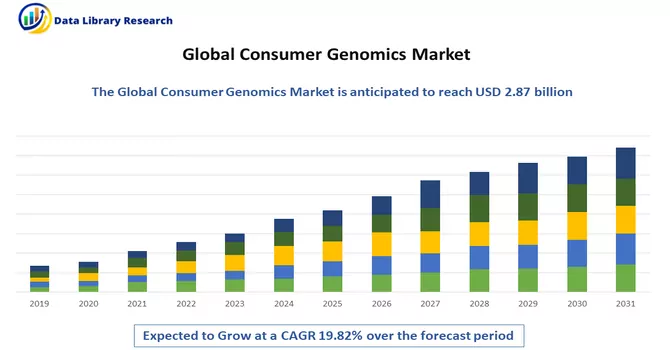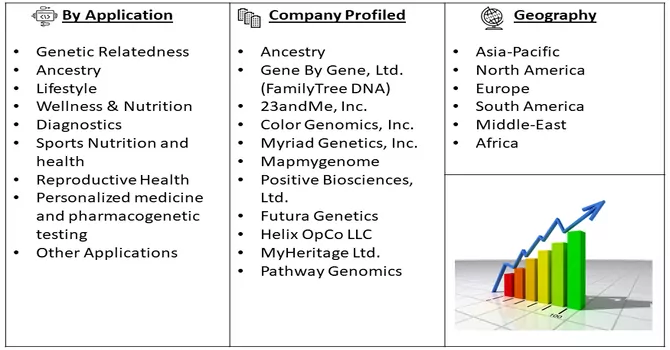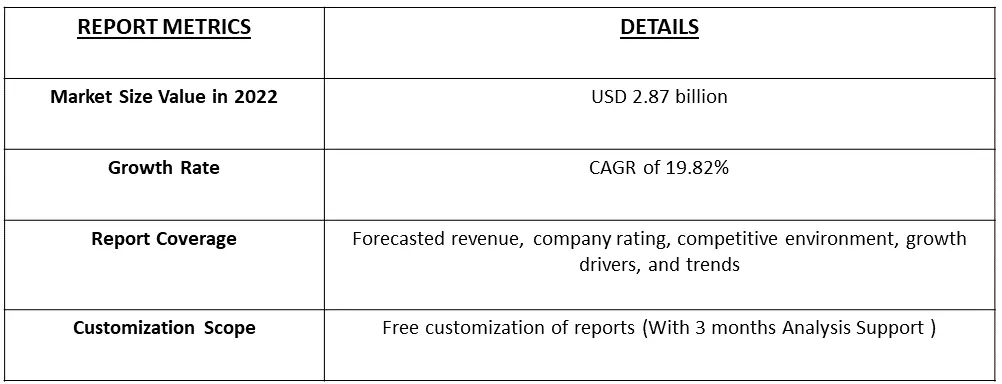The global consumer genomics market, valued at approximately USD 2.87 billion in 2022, is anticipated to witness significant growth, reaching an estimated value of around USD 17.51 billion by 2032. This projected expansion reflects a robust compound annual growth rate (CAGR) of 19.82% during the forecast period spanning from 2023 to 2032.

Get Complete Analysis Of The Report - Download Free Sample PDF
Consumer genomics comprises both direct-to-consumer applications, wherein individuals access genetic testing directly from commercial companies rather than through healthcare providers, and consumer-driven genetic testing, which involves genetic testing ordered by healthcare providers in response to informed patients. Several key factors contribute to the anticipated growth of this market. These include an increase in government funding dedicated to supporting genomics projects, a rise in the incidence and prevalence of viral diseases and genetic disorders, a growing occurrence of cancer, and the expanding applications of Next-Generation Sequencing (NGS) in cancer research. Additionally, the market is witnessing the entry of new players and startups, further diversifying and driving growth within this market segment.
Consumer genomics companies are expanding their global footprint, reaching new markets, and tailoring their services to diverse populations. This trend reflects the increasing demand for genetic testing services on a global scale and the recognition of the importance of genetic diversity in healthcare. Moreover, the integration of AI and ML in consumer genomics is enhancing the interpretation of genetic data. These technologies aid in providing more accurate risk assessments, personalized recommendations, and insights into complex genetic relationships, contributing to a deeper understanding of individual genetic information. The notable trends are anticipated, with advancements in single-cell sequencing technologies taking the forefront. These improvements are expected to enhance throughput, accelerate analysis processes, and boost overall accuracy. Consequently, these developments have the potential to unveil novel insights into the significance of individual cells in diseases and various biological processes.
Market Segmentation: The Consumer Genomics market is segmented by Application (Genetic Relatedness, Ancestry, Lifestyle, Wellness, & Nutrition, Diagnostics, Sports Nutrition and health, Reproductive Health, Personalized medicine and pharmacogenetic testing, and Other Applications) and by Geography (North America, Europe, Asia-Pacific, South America, and Middle East and Africa). The report offers market size and forecasts in value (USD Million) for all the above segments.

For Detailed Market Segmentation - Download Free Sample PDF
Market Drivers :
Rise in Interest of Consumers & Physicians in DTC Kits & Consequent Rise in Sales of DNA.
The surge in consumer and physician interest in Direct-to-Consumer (DTC) kits has resulted in a subsequent increase in the sales of DNA and the consumer genomics market. This heightened interest reflects a growing curiosity among consumers and healthcare professionals to explore personal genetic information, leading to a notable uptick in the adoption of DTC kits and driving sales within the consumer genomics sector. As of July 2022, 1health.io Inc. has notably broadened its testing capacities across both clinical and direct-to-consumer domains. Furthermore, the company has entered into a strategic partnership with Apollo Health Group to expand the clinical market for Apollo's specialized and high-performing Next-Generation Sequencing (NGS) assays. These assays encompass pharmacogenetics screenings (PGx) and hereditary cancer genetic screenings (CGx). These progressive developments are actively contributing to the expansion and advancement of the market. Thus, the market is expected to witness significant growth over the forecast period.
Consumer Genomics Market Increase in Access to DTC Services due to Reducing Cost of Genotyping.
The reduction in the cost of genotyping is facilitating an increase in access to Direct-to-Consumer (DTC) services, particularly in the field of regenerative medicine. As the cost of genotyping continues to decline, it has become more economically feasible for a broader range of individuals to avail themselves of DTC genetic services. This accessibility is contributing to the democratization of genomics, allowing more people to explore their genetic information and engage with regenerative medicine applications, fostering a more inclusive and widespread adoption of these innovative healthcare services. Thus, the market is expected to witness significant growth over the forecast period.
Market Restraints.
Ethical and Clinical Issues Pertaining to the Use of DTC Products & Personalized Treatment.
The growth of regenerative medicine is impacted by ethical and clinical issues related to the use of Direct-to-Consumer (DTC) products and personalized treatment approaches. The ethical considerations surrounding DTC products include concerns about the privacy and security of individuals' genetic information, potential misinterpretation of genetic results, and the responsible handling of sensitive health data. Additionally, the clinical issues involve the need for accurate and validated genetic information to inform personalized treatment plans, ensuring the safety and efficacy of regenerative therapies. The responsible and ethical use of DTC genetic information is crucial for maintaining public trust and confidence in regenerative medicine. Addressing these ethical and clinical challenges is essential for the sustainable growth and integration of personalized treatments within the field of regenerative medicine.
The pandemic prompted a significant shift in research priorities and funding toward understanding the virus, developing diagnostics, and exploring therapeutic options for COVID-19. As a result, some regenerative medicine projects may have experienced delays or redirection of resources. The transition to remote work and virtual collaborations became more prevalent in the scientific community. This shift could have influenced collaborative efforts in regenerative medicine research, fostering new ways of sharing knowledge and expertise. Thus, he COVID-19 pandemic presented challenges to the regenerative medicine field, it also prompted adaptations and innovations in research, funding, and healthcare delivery. The long-term impact on regenerative medicine will depend on the duration and severity of the pandemic and the strategies employed by researchers, healthcare providers, and industry stakeholders to navigate these challenges.
Segmental Analysis:
Personalized medicine and pharmacogenetic testing Segment is Expected to Witness Significant Growth Over the Forecast Period.
Personalized medicine tailors medical treatments to individual characteristics, including genetic makeup, lifestyle, and environmental factors. In the context of regenerative medicine, personalized approaches involve customizing therapies based on a patient's specific biological characteristics. Moreover, ongoing research in pharmacogenetics contributes valuable insights to the development of targeted and personalized regenerative therapies. Understanding how genetic variations influence treatment responses informs the design of more precise and patient-specific interventions. Thus, the segment is expected to witness significant growth over the forecast period.
North America Region is Expected to Witness Significant Growth Over the Forecast Period.
North America hosts a significant number of clinical trials related to regenerative medicine. The region's emphasis on translational research, bridging the gap between laboratory discoveries and clinical applications, has propelled the evaluation and development of regenerative therapies in real-world settings. Moreover, North America attracts significant investment and venture capital activity in the regenerative medicine space. The availability of funding supports research initiatives, clinical trials, and the development of regenerative medicine startups, contributing to the growth and dynamism of the sector.
Furthermore, in Canada, there is a growing emphasis on government initiatives aimed at bolstering genomics projects, which is anticipated to augment the country's proficiency in Direct-to-Consumer (DTC) genetics. The Canadian Medical Association (CMA) is actively endorsing initiatives to enhance public knowledge and education, fostering increased awareness among patients regarding the potential benefits and constraints associated with DTC genetic testing. Additionally, the CMA is actively involved in the ongoing training of healthcare providers to ensure they remain abreast of the rapid advancements in molecular genetics. Thus, the market is expected to witness significant growth over the forecast period.

Get Complete Analysis Of The Report - Download Free Sample PDF
Ancestry
Recent Developments:
1) In October 2022, A specialty laboratory with life-saving plasma tests, GC LabTech FDA-registered, chose 1health.io to provide its cutting-edge new lab tests directly to consumers.
2) In November 2022, a genomics-based research company, Strand Life Sciences announced the launch of a new line of genomic-based tests, Strand Genomic Wellness. The newly launched genomic-based tests are developed for preventive wellness.
Q1. What was the Consumer Genomics Market size in 2022?
As per Data Library Research The global consumer genomics market, valued at approximately USD 2.87 billion in 2022.
Q2. At what CAGR is the Consumer Genomics Market projected to grow within the forecast period?
Consumer Genomics Market growth rate (CAGR) of 19.82% during the forecast period.
Q3. Which Region is expected to hold the highest Market share?
North America region is expected to hold the highest Market share.
Q4. Who are the key players in Consumer Genomics Market?
Some key players operating in the market include
Data Library Research are conducted by industry experts who offer insight on industry structure, market segmentations technology assessment and competitive landscape (CL), and penetration, as well as on emerging trends. Their analysis is based on primary interviews (~ 80%) and secondary research (~ 20%) as well as years of professional expertise in their respective industries. Adding to this, by analysing historical trends and current market positions, our analysts predict where the market will be headed for the next five years. Furthermore, the varying trends of segment & categories geographically presented are also studied and the estimated based on the primary & secondary research.
In this particular report from the supply side Data Library Research has conducted primary surveys (interviews) with the key level executives (VP, CEO’s, Marketing Director, Business Development Manager and SOFT) of the companies that active & prominent as well as the midsized organization
FIGURE 1: DLR RESEARH PROCESS

Extensive primary research was conducted to gain a deeper insight of the market and industry performance. The analysis is based on both primary and secondary research as well as years of professional expertise in the respective industries.
In addition to analysing current and historical trends, our analysts predict where the market is headed over the next five years.
It varies by segment for these categories geographically presented in the list of market tables. Speaking about this particular report we have conducted primary surveys (interviews) with the key level executives (VP, CEO’s, Marketing Director, Business Development Manager and many more) of the major players active in the market.
Secondary ResearchSecondary research was mainly used to collect and identify information useful for the extensive, technical, market-oriented, and Friend’s study of the Global Extra Neutral Alcohol. It was also used to obtain key information about major players, market classification and segmentation according to the industry trends, geographical markets, and developments related to the market and technology perspectives. For this study, analysts have gathered information from various credible sources, such as annual reports, sec filings, journals, white papers, SOFT presentations, and company web sites.
Market Size EstimationBoth, top-down and bottom-up approaches were used to estimate and validate the size of the Global market and to estimate the size of various other dependent submarkets in the overall Extra Neutral Alcohol. The key players in the market were identified through secondary research and their market contributions in the respective geographies were determined through primary and secondary research.
Forecast Model
